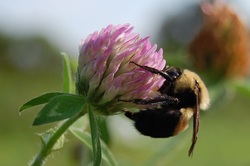 Throughout the winding streets of Somerville, Cambridge, and Boston, the flowering trees and gently falling blossoms announce spring. The city’s thoroughfares buzz with activity and people eagerly greet the sun’s warm rays. Kayaks, crew shells, and sailboats glide along the Charles River, signaling an end to a “hibernating” city. As my daughter eagerly points out, the streets buzz not only with people, but with one of the first and most important native wild pollinators to emerge. The furry, booming bumble bees. Bumble bees are in the genus, Bombus, translating to “booming”, which captures the cacophonous and frenzied pace of a bumble bee racing from flower to flower. It's called flight of the bumble bee for a reason. In the spring, you’ll probably notice that the bumble bees are much larger than you would see in the summer because the bumble bees flying around, searching for a nest site, and collecting nectar and pollen at cherry, apple, or holly flowers - to name a few - are queen bees, beginning their epic quest to start their own colony. Before I talk more about the booming queens you see and hear whizzing by you this spring, let’s back up to last fall. In the summer and early fall when these nascent queens, who were carefully reared by the colony the previous summer, emerged, they had three critical jobs: 1) mate with male drones, 2) build up fat reserves by foraging on pollen and nectar, which allowed them to survive the winter and emerge the following spring, and 3) hibernate (it's more accurate to say they are dormant during the winter). To hibernate, most bumble bees are poor diggers and a queen will usually dig a hole in loose disturbed soil to create a cavity where it will remain during the winter. In the spring, once queens emerge from hibernation (dormancy), they need to stock up on nectar and pollen and find a suitable nesting site to form a colony. However, it can be really cold in the spring and life is very precious for newly emerged queens. Bumble bees can warm themselves up and get moving on cool spring days. Check out this fantastic BBC video narrated by Sir David Attenborough and watch the thermal images of a bumble bee on a cold spring morning: Nesting
Bumble bee species vary, but most species will either nest in 1) pre-existing holes and cavities in the ground, like abandoned mouse nests, 2) some will nest just above the ground in the grass, under moss, or in tussocks, or 3) some species will use old bird nests, cavities in the foundations of houses or under sidewalks (like at my apartment where there is a Bombus bimaculatus colony), tree cavities, or bird boxes. A common characteristics of many nest sites is the presence of insulating material, like feathers, leaves, and moss. Once a suitable nest is found, the queen bumble bee lays her first batch of eggs (usually between 8-16). During this time, the queen will care for and keep the brood warm, while continuing to forage for pollen and nectar that she’ll use to feed the developing larvae. After 4 to 5 weeks, the first set of workers will emerge (you’ll start to notice smaller bees flying around - the B. bimaculatus colony just had their first workers emerge this week) and the queen will lay eggs while the workers will care for the brood and forage for nectar and pollen. To Learn More:
1 Comment
|
AuthorI am curious about nature and the wonderful species interactions I read about and see on a daily basis. Archives
November 2013
Categories
All
|

 RSS Feed
RSS Feed
